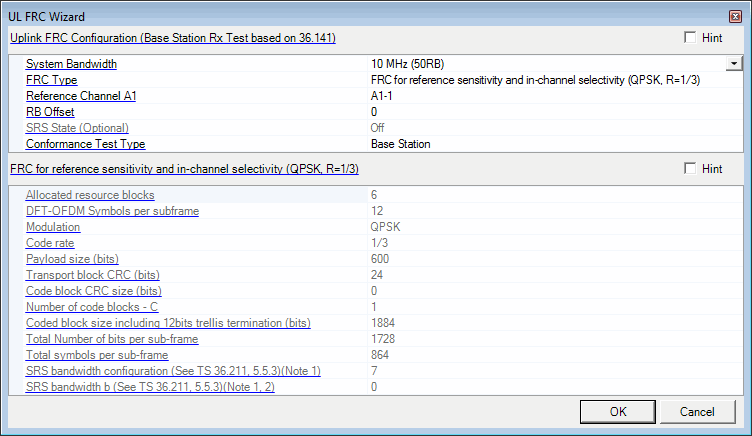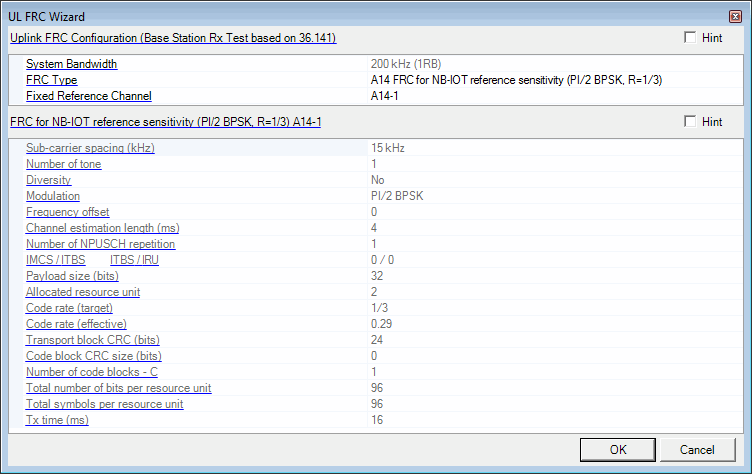
E-UTRA and eMTC

NB-IoT

Double-click or use the drop-down menu to set the system bandwidth and number of resource blocks for the fixed reference channel.
Any combination of System Bandwidth and Reference Channel can be selected on the FRC Wizard window, and an error check is executed after clicking the OK button.
For Reference Channel A1-8, A1-9, A2-4, and A2-5 are an exception, System Bandwidth and Reference Channel combination is limited. (A1-8 and A2-4 for 10 MHz System Bandwidth, A1-9 and A2-5 for 20 MHz System Bandwidth)
If RB Size of the Reference Channel is larger than the System Bandwidth, an error message is displayed and FRC wizard is aborted.
Double-click or use the drop-down menu to set the FRC type. The software sets the parameters displayed in the lower section of the window to predetermined values for the FRC Type and Reference Channel as shown in the table below:
|
Reference Channel |
|
|---|---|
|
FRC for reference sensitivity and in-channel selectivity (QPSK, R=1/3) |
A1-1 to A1-5 |
|
FRC for dynamic range (16QAM, R=2/3) |
A2-1 to A2-3 |
|
FRC for performance requirements (QPSK, R=1/3) |
A3-1 to A3-7 |
|
FRC for performance requirements (16QAM, R=3/4) |
A4-1 to A4-8 |
|
FRC for performance requirements (16QAM, R=3/4) |
A5-1 to A5-7 |
|
PRACH Test Preambles Note: Supported in PRACH Preamble Configuration Wizard |
A6-1 to A6-2 *see note |
|
FRC for UL timing adjustment (Scenario 1) |
A7-1 to A7-6 |
|
FRC for UL timing adjustment (Scenario 2) |
A8-1 to A8-6 |
|
FRC for PUSCH with TTI bundling and enhanced HARQ pattern |
A11-1 |
Choice:
A1-1 | A1-2 | A1-3 | A1-4 | A1-5 | A1-6 | A1-7 (System Bandwidth is other than 10 MHz or 20 MHz, and FRC Type is FRC for reference sensitivity and in-channel selectivity (QPSK, R=1/3))
A1-1 | A1-2 | A1-3 | A1-4 | A1-5 | A1-6 | A1-7 | A1-8 (System Bandwidth is 10 MHz, and FRC Type is FRC for reference sensitivity and in-channel selectivity (QPSK, R=1/3))
A1-1 | A1-2 | A1-3 | A1-4 | A1-5 | A1-6 | A1-7 | A1-9 (System Bandwidth is 20 MHz, and FRC Type is FRC for reference sensitivity and in-channel selectivity (QPSK, R=1/3))
A2-1 | A2-2 | A2-3 (System Bandwidth is other than 10 MHz or 20 MHz, and FRC Type is FRC for dynamic range (16QAM, R=2/3))
A2-1 | A2-2 | A2-3 | A2-4 (System Bandwidth is 10 MHz, and FRC Type is FRC for dynamic range (16QAM, R=2/3))
A2-1 | A2-2 | A2-3 | A2-5 (System Bandwidth is 20 MHz, and FRC Type is FRC for dynamic range (16QAM, R=2/3))
A3-1 | A3-2 | A3-3 | A3-4 | A3-5 | A3-6 | A3-7 (FRC Type is FRC for performance requirements (QPSK, R=1/3))
A4-1 | A4-2 | A4-3 | A4-4 | A4-5 | A4-6 | A4-7 | A4-8 (FRC Type is FRC for performance requirements (16QAM, R=3/4))
A5-1 | A5-2 | A5-3 | A5-4 | A5-5 | A5-6 | A5-7 (FRC Type is FRC for performance requirements (64QAM, R=5/6))
A7-1 | A7-2 | A7-3 | A7-4 | A7-5 | A7-6 (FRC Type is FRC for UL timing adjustment (Scenario 1))
A8-1 | A8-2 | A8-3 | A8-4 | A8-5 | A8-6 (FRC Type is FRC for UL timing adjustment (Scenario 2))
A11-1 (FRC Type is FRC for PUSCH with TTI bundling and enhanced HARQ pattern)
Default: Ax-1 Note) x is FRC Type number.
Double-click or use the drop-down menu to set the Ax value for the FRC.
The software adjusts corresponding parameter values in the lower section based on your selection.
Any combination of System Bandwidth and Reference Channel can be selected on the FRC Wizard window, and an error check is executed after clicking the OK button.
For Reference Channel A1-8, A1-9, A2-4, and A2-5 are an exception, System Bandwidth and Reference Channel combination is limited. (A1-8 and A2-4 for 10 MHz System Bandwidth, A1-9 and A2-5 for 20 MHz System Bandwidth)
If RB Size of the Reference Channel is larger than the System Bandwidth, an error message is displayed and FRC wizard is aborted.
Range: 0 to the number of resource blocks determined by the System Bandwidth selection.
Default: 0
Sets the resource block offset for the FRC when the FRC Type is set to anything other than FRC for PUSCH with TTI bundling and enhanced HARQ pattern.
When the FRC Type is set to FRC for PUSCH with TTI bundling and enhanced HARQ pattern, this parameter displays the resource block offset. In this case, 3 contiguous resource blocks should be in the middle of the channel bandwidth. When the number of resource blocks in the channel bandwidth is even, the 3 contiguous resource blocks in the middle with lower numbers are used as follows:
1 (1.4MHz System BW case)
6 (3MHz System BW case)
11 (5MHz System BW case)
23 (10MHz System BW case)
36 (15MHz System BW case)
48 (20MHz System BW case)
Displays the sounding reference signal (SRS) State.
Choice: Base Station | Repeater
Default: Base Station
Double-click or use the drop-down menu to set the Conformance Test type. The software sets the parameters displayed in the lower section of the window to predetermined values for the Conformance Test type and the FRC Type.
Base Station: Reference is 3GPP TS 36.141.
Repeater: Reference is 3GPP TS 36.143.
Choice:
A14-1 | A14-2 (FRC Type A14 case)
A15-1 | A15-2 (FRC Type A15 case)
A16-1 | A16-2 | A16-3 | A16-4 | A16-5 (FRC Type A16 case)
Double-click or use the drop-down menu to set the fixed reference channel (FRC).
The software adjusts corresponding parameter values in the lower section based on your selection.
See 3GPP TS36.141 A14, A15 and A16 for more information.
*The title and parameters displayed, are dependent on the FRC Type selected.
Displays the allocated resource blocks for the selected Reference Channel.
Displays the DFT-OFDM symbols per subframe.
Displays the modulation type for the selected Frequency Reference Channel type.
Displays the code rate for the selected FRC Type.
Displays the payload size for the selected FRC Type and the Reference Channel's "A" value.
Displays the code block CRC size, in bits, for the selected FRC Type and the Reference Channel's "A" value.
Displays the code block CRC size, in bits, for the selected FRC Type and the Reference Channel's "A" value.
Displays the number of code blocks for the selected FRC Type and the Reference Channel's "A" value.
Displays the coded block size for the selected FRC Type and Reference Channel “A” value.
Displays the number of bits per subframe for the selected FRC Type and the Reference Channel's "A" value.
Displays the number of symbols per subframe for the selected FRC Type and the Reference Channel's "A" value.
Displays the sounding reference signal (SRS) bandwidth configuration for the selected Reference Channel. (See 3GPP TS 36.211.5.5.3)
To enable this parameter, FRC Type must have either FRC for UL timing adjustment (Scenario 1) or FRC for UL timing adjustment (Scenario 2) selected.
Displays the sounding reference signal (SRS) bandwidth for the selected Reference Channel. (See 3GPP TS 36.211.5.5.3).
To enable this parameter, FRC Type must have either FRC for UL timing adjustment (Scenario 1) or FRC for UL timing adjustment (Scenario 2) selected.
Displays the sub-carrier spacing (kHz) for the fixed reference channel (FRC).
Displays the number of tone or number of sub-carriers for the fixed reference channel (FRC).
Displays the diversity for the fixed reference channel (FRC).
Displays the frequency offset for the fixed reference channel (FRC).
Displays the channel estimation length (ms) for the fixed reference channel (FRC).
Channel estimation lengths are included in this parameter list for information only.
Displays the number of NPUSCH repetition for the fixed reference channel (FRC).
Displays the IMCS / ITBS for the fixed reference channel A14 or A15.
Displays the ITBS / IRU for the fixed reference channel A16.
Displays the allocated resource unit for the fixed reference channel (FRC).
Displays the code rate (target) for the fixed reference channel (FRC).
Displays the code rate (effective) for the fixed reference channel (FRC).
Displays the total number of bits per resource unit for the fixed reference channel (FRC).
Displays the total symbols per resource unit for the fixed reference channel (FRC).
Displays the transmission time (ms) for the fixed reference channel (FRC).